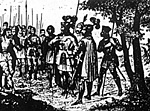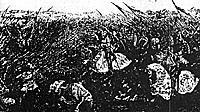1.4.6 Hunnic Equipment and Horses

Horses Since the Huns are superb riders, "almost glued to their horses," it is appropriate to take a little time examining the Hunnic horse. Their horses which are hardy, it is true, but ugly. ( 35 ) are central to the Hunnic lifestyle and mode of warfare. Thompson maintains that the pasture of horses of the Huns could do less work than the stall fed horses of the Romans; and they quickly remountd themselves on Roman horse. Maenchen-Helfen di sagrees with this, quoting Vegetius, who condemns the practice of leaving Roman horses out to pasture all year, following the example of Huns and other barbarians. The Roman horses, away from shelter and a warm winter stable, became ill.
Vegetius placed the Hunnic horse as the most suitable breed for warfare because of its patient perseverance, and capacity to endure cold and hunger. Hunnic horses a described as having great hooked beads, protruding eyes, narrow nostril broad Jaws, strong and stiff necks, manes banging below the knee, overlarge ribs, curved backs, bushy tails, cannon bones of great strength, small pasterns, wide-spreading hooves, hollow loins; their bodies are angular with no fat on the rump or the muscles of the back, their stature inclining to length rather than height, the belly drawn, the bones huge. The thinness of these horses is pleasing, and there is beauty even in the ugliness ( 36 ) .
The horses were saddled with vooden saddles but without stirrups. Huns controlled their horses with whips.
As a postscript to this section on horses, Leo, in his Problemata, advises one to attack steppe borsemen in the months of February and March when their horses are weakened by the hardships of winter. On this occasion the stall fed Roman horses would be at an advantage.
Armoured Cavalry The majority of Hunnic cavalry rode and fought with little or no body armour. Like many other non-Ronan societies of the time, armour was the privilege of a few. The most comoon steppe armour was scale armour, usually or bone, horn, bronze or iron. Mail had started to supersede scale arocur, probably as a result of closer contact witn the west. Armour, once acquired, would be handed down from one generation to the next. Thus, so long as the Huns continued to be successful on the Battlefield, and continued to obtain wealth and booty, there vould have been a steady growth in the number of Huns who possessed armour.
Incidentally, the much plainer horn or bone armour should not be regarded as inferior to metallic armour, as Pausanias points out when deacribing Sarmatian corselets. Thee Sarmatians
-
"collect the hoofs of their mares, clean them, and split them till they resemble the scales of a dragon. Anybody who has not seen a dragon has at least seen a green fir cone. Well, the fabric which they made out of the hoofs may not be inaptly likened to the clefts on a fir cone. In these pieces they bore holes, and having stitched them togetner with the sinews of horses and oxen, they use them as corselets, which are inferior to Greek breast-plates neither in elegance nor strength, for they are both sword-proof and arrov-proof(37)..
Helmets, like armour, would also have been worn. In fact, the noses of noble Hun boys was artificially flattened in order that the bead could accommodate the nosepiece of a helmet.
Shields Hunnic shields were of wickerwork, without bosses, and possibly covered in leather.
Summary of Hunnic Equipment The majority of Hunnic cavalry were lightly armoured with leather or no body armour, and wearing a soft leather or felt cap. They vere armed with javelin or spear, bow, lasso, sword and small shield (38).
The nobles wore scale or mail body armour, with a metal helmet, and were armed with lance, bow, lasso, sword and shield.
The Huns as Infantry Ferrill maintains in his interesting book The Fall of the Roman Empire that the Huns, although initially mounted warriors, were forced to become foot soldiers in Europe. I agree that in the 440's and 450's Attila's army contained many foot warriors, mainly Germanic tribesmen, but I do not support the view that the Huns ever became foot soldiers. A Hun would throw away his battlefield edge if he abandoned his horse, and I can see no direct or indirect evidence of this happening. Ferrill's argument is based on the limited ability of the Hungarian Plain to support horses, claiming 15,000 cavalry to be the upper limit tnat could be aupported (39).
This ignores a number of points:
1.5 Wargaming the Huns
1.5.1 Introduction
Let us move away from the historica1 background information, onto the wargaming aspect of using Huns. In this section I intend to discuss wargaming in general, produce a battle report, and discuss a campaign scenario. Incidentally, the battle report is of a fictitious battle.
the most famous battle of the time involving the Huns is of course the battle of Charlons/Campus Mauriacus/Orleans. I will not describe this battle because it is well documented (42).
I do not intend to draw up an army list, since most commercial rules have suitable lists available. I will restrict myself to a couple of comments.
Some lists give the Hunnic light cavalry "average" morale only. I believe this is incorrect for cavalry that haa been described as the the most formidable warriors of the century. Hun light cavalry should have a morale status that can range from "average" to "high," perhaps organised into units with mixed morale class. Nobles have, of course, "high" morale. I also agree with Simon MacDowall's comment (120.19) that Alan light cavalry should not have higher morale status than the Huns. Alan cavalry allied with the Huns should have "average" morale status.
For a siege game, the Hunnic army should be allowed siege equipment and artillery.
1.5.2 General Wargaming Principles
Many rule writers insist that their rules do not discriminate against armies or troop types, but inevitable this is not so. I remember when Huns were quite popular under early editions of WRG, but 6th edition gave them a hard time (see D. Hannan's battle report in Slingshot 99.12). Fortunately, for WRGers, WRG 7th edition is a little kinder to the humble Hun. I am not criticising any writers; the point is that different rules emphasise different characteristics. However, the general principles should remain the same, so this section is not written to be rule-specific. Hunnic tactics can be isolated into their separate elements, but remember that it is the successful combination of these elements that make a Hun army formidable.
Surprise As you read earlier, Huns used flank marches, night attacks and force marches frequently and effectively. So use them. Don't just flank march with a unit, send an entire wing out. If you send enough units the opponents will probably have trouble containing the attack, and you can use your speed of movement with free units to threaten the enemy rear (or better still, loot the baggage camp!). Surprise always means doing the unexpected, turning up one day with all the Gepid and Gothic allies in tow will probably upset your opponent.
 Speed of Movement. Huns need to utilise their speed - to
exploit gaps in the enemy line, turn an open flank, avoid superior
enemy numbers or weight, or concentrate for a sudden attack on an
unsupported or disordered unit. The enemy will probably try to negate
this by enmeshing you in melee, or trap pu against terrain, so beware!
Speed of Movement. Huns need to utilise their speed - to
exploit gaps in the enemy line, turn an open flank, avoid superior
enemy numbers or weight, or concentrate for a sudden attack on an
unsupported or disordered unit. The enemy will probably try to negate
this by enmeshing you in melee, or trap pu against terrain, so beware!
Missile Attack. The Bow is your primary weapon, not the javelin (or the lasso!). Tne best use of the bow is to goad enemy cavalry into charges, but if you can concentrate your fire, it can sometimes be used to break up infantry formations.
Melee Should not be entered unless you have some sort of perceived advantage e.g. disordered or outflanked enemy. I am often tempted into an equal melee, which I usually manage to lose, so it serves me right. The rule is: if you can't beat 'em, evade 'em.
Battle Plan A Hun's battle plan must obviously capitalise on its strengths of speed and missiles and minimise its weaknesses - lack of rough terrain troops and lack of shock troops. Thus it goes without saying that frontal attacks are not likely to be successful. Your best options are: double envelopment, attack on one wing, or a flank march.
The Battle This is where all the elements come together. Advice is difficult here, because every situation is different. Remember that if your initial plan is nullified, the natural mobility of the Hun army allows you attack from one direction to another rapidly. This can be exploited if the enemy commits reserves to a perceived attack too early.
The Huns, unlike most armies, need not worry about maintaining a continuous front. Thus an army consisting of two widely separated wings and centre is a tactical possibility that few other armies can utilise.
A Hunnic army can appear to be frustrating to use, because you have no battle shock capacity. You must gnaw at the enemy's wings, try and lure it out of positions, and avoid contact till you are ready to pounce. Remember that you opponent is also probably getting fed up because if you keep evading, he has nothing solid to attack, nothing to pin down and brawl with. Wait for him to make the mistake.
Problems Foot archers are a problem because they can hit you from a distance, and you usually cannot outshoot them. All you can do is to try and keep at a diatance, and keep skirmishing. The other major headache is elephants. The only options you have is to try and shoot them down or avoid them. The white Huns managed to deal with them in India and Persia, it seems, by long range missile fire.
More Huns
-
The Huns Part 1: Introduction, Sources, At War
The Huns Part 1: On Campaign
The Huns Part 2: Fortifications and Sieges
The Huns Part 2: In Battle
The Huns Part 3: Equipment and Wargaming
The Huns Part 3: Battle of Naissus
The Huns Part 3: Wargaming Campaign
Back to Saga #51 Table of Contents
Back to Saga List of Issues
Back to MagWeb Master Magazine List
© Copyright 1995 by Terry Gore
This article appears in MagWeb (Magazine Web) on the Internet World Wide Web. Other military history articles and gaming articles are available at http://www.magweb.com